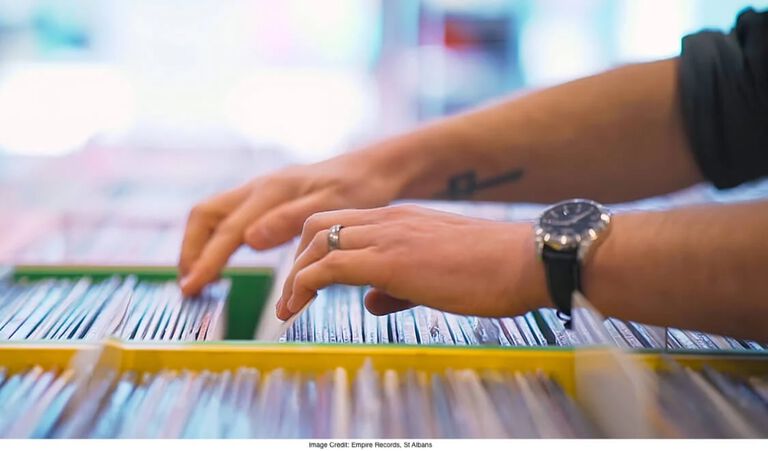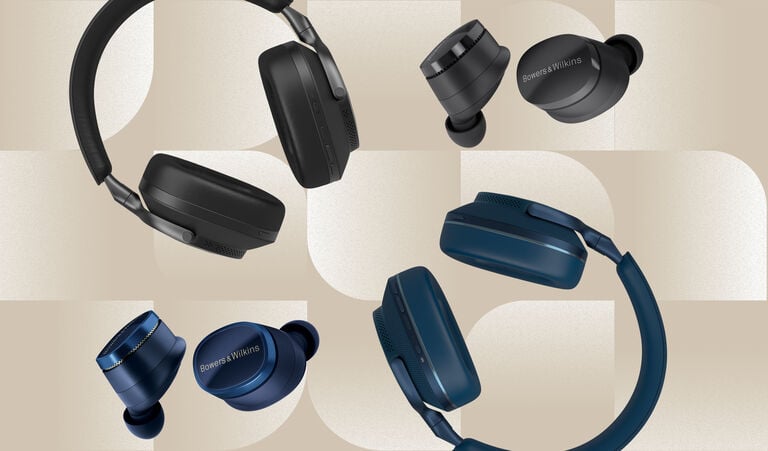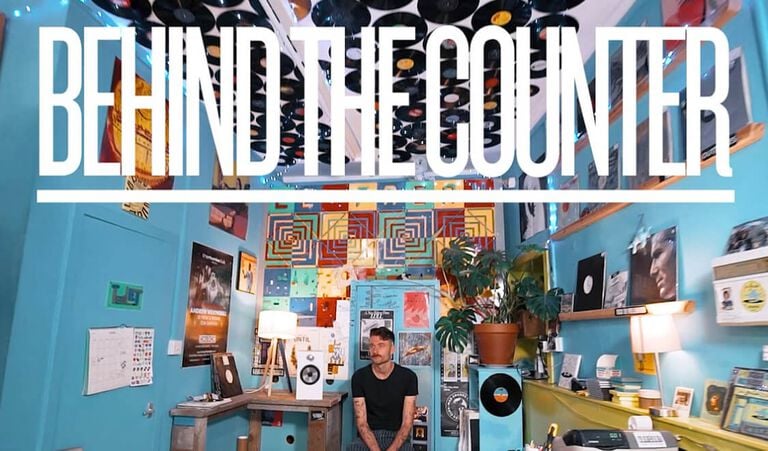Behind The Desk | Part 1: In Conversation with Mastering Legend Geoff Pesche
Welcome to Behind The Desk, a new blog series in which Bowers & Wilkins speaks with some of the music industry's finest practitioners. From mixing and mastering engineers to composers and producers, join us as we explore their craft, careers and inspirational stories.
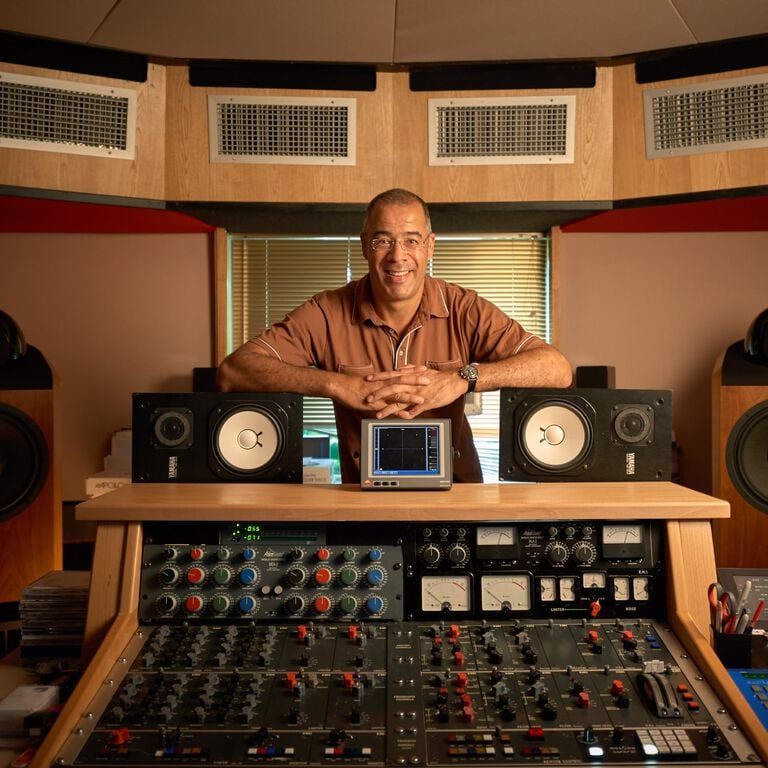
For our first instalment, we feature Geoff Pesche, a renowned mastering engineer with over four decades of experience. Having worked on countless iconic albums across multiple genres, Pesche brings an expert ear and technical finesse to every project.
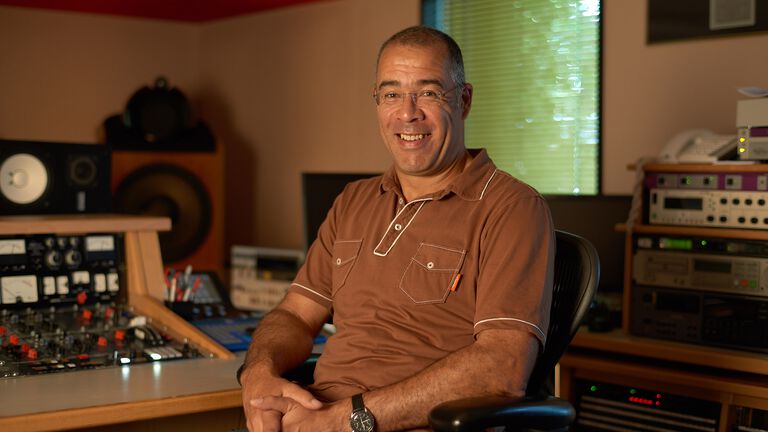
Geoff Pesche: A Mastering Legend at Abbey Road
Geoff Pesche is one of the most respected mastering engineers in the industry, and is now based at the world-famous Abbey Road. With a career spanning over 40 years, Pesche has worked with some of the biggest names in music, bringing his expertise to a vast array of projects. His work has covered genres from rock and pop to electronic and beyond, mastering records for legendary artists such as Gorillaz, Kylie Minogue, Coldplay, Pulp, Duran Duran and Elton John.
Pesche plays a crucial role in the final stages of music production, ensuring records are polished, balanced and ready for release across various formats. At Abbey Road, he has been at the forefront of mastering and remastering, contributing to the resurgence of vinyl and the preservation of classic albums. His work on projects such as Pulp’s Different Class and Duran Duran’s catalogue showcases his ability to respect original recordings while enhancing them for modern listeners.
Key components of Pesche’s mastering setup are our 801 loudspeakers, which he relies on every day to achieve the highest level of audio precision. They allow him to make critical adjustments, ensuring every record he masters sounds its absolute best across all listening environments.
In this exclusive interview, we sit down with Geoff Pesche to discuss his career, the art of mastering and the evolving landscape of music production. Join us as we go behind the desk with one of the industry’s most revered engineers.
Bowers & Wilkins:
It would be great to start off by learning a little bit about you and what kick-started your life in music.
Geoff Pesche:
I've been a record fan forever. I got a job as a bike messenger for a post-production firm in the West End in about 1977, delivering tapes for about eight months, and then, eventually, came up to tape copying. It was all tape, records and cassettes then. I was tape copying for about six months, and got on really well with the disc-cutting engineer and they trained me to cut records.
I took a shine to it. After about a year to 18 months with them, they let me loose with the clients. That flourished and I worked there for 10 years. When I left, I had a client base; it’s much like hairdressing, people are very loyal to you. I moved from there to Utopia up in Chalk Farm, and a lot of them followed me. I moved again and moved again and now I’m at Abbey Road.
Bowers & Wilkins:
How did you get involved in mastering?
Geoff Pesche:
I've always worked in post-production – I've never been a studio engineer. I've always been a physical disc-cutting engineer, which morphed into mastering when vinyl went away and when CDs became popular in the early 90s.
Bowers & Wilkins:
Can you explain what mastering is and how it fits into the process of creating a record?
Geoff Pesche:
Mastering is the last link in the production chain, where you can alter the sound of a format before it's manufactured. We're doing sequencing, tonal balance, final editing, and having a row with the band. All that last-chance stuff that needs to be done because it's going to be on Amazon in a week. It happens in this mastering suite – or in rooms like this.
The difference between a mixing engineer and a mastering engineer is time-based. Mastering engineers are very final. Mixers are not.
Rooms like this, where you can change things in tonality, are very important to people who are craftsmen of music. We listen to final details on great monitors and make the final edits to a mixed piece of music. And, hopefully, we listen on a pair of Bowers & Wilkins to get the best out of what the song can be right up to the last minute.
Bowers & Wilkins:
In the mixing process, can you change things like relative positioning and the relative level of different musical elements?
Geoff Pesche:
Yeah, you can change all those things, but nothing else. Whereas in the mastering process, you’re working with things like tonality and frequency balance.
Bowers & Wilkins
How does the process differ for the likes of remastering records?
Geoff Pesche:
Remastering is great. Having worked in London for about 40 years, loads of records that I mastered back in the day are now getting remastered. If you can find the original master tapes, the original producer or mixer and the original mastering engineer, you’re laughing because you're going back through the production chain.
There have been a few projects I’ve done during the last two years that I actually did the first time around. All the Pulp records – I did with Jarvis; I did Different Class last year. It was 1995 when we did it with Chris Thomas. Chris Thomas wasn't around, but we did it again from almost the same sources.
The difference with remastering is about source material. If you can find the right source material, you can go back to the bricks and remaster it properly. Generally, with the catalogue stuff, we get files that are digitised in the States and then sent to us. I don't know about their D to A conversion rate, but they sound good. They're from the most original masters that they can find, so that’s great.
When you're mastering something that's new, it’s totally down to you and how your ears behave that day. But if it’s something you've done before, you might remember bits about it. I would remember using that record as an example. That record sounded fantastic off the tapes in 1995, so I remember doing very little to it within the desk. I just made it a bit louder and chucked it at a factory. I didn't need to overdo it or over-process it.
With that knowledge in mind, I can respect the master tapes from back then. It would be easy to just turn the treble and the bass up, but that doesn't respect the original record. And, often, you sometimes get an original record to reference – so you can hear how it sounded then.
Bowers & Wilkins:
What are you trying to achieve with a remaster? If you're remastering your own work from about 20-30 years ago, how do you approach that process?
Geoff Pesche:
I've got a sonic picture in my mind – and over thirty years, although my ears have changed quite a bit, I still know what sounds good. With remastering, you've got to respect the mixes and you mustn't detract from what the master tape sounds like.
A lot of the records from the 80s sound really thin and lack bass. I just did a load of Duran Duran for Warner, and there's no bass in them, but that's how they sounded. I re-cut 32 Elton John records for Warner last year, and after listening to Caribou, it sounded like there was no bass. But that's how it sounded. You have to respect the original release. That's the art of remastering.
With mastering, you’ve got kind of a blank canvas because the mix is brand new. You can suggest that this should be a bit warmer, this could be a bit brighter, and it works because it's brand new. You've got a free run at it. But with remastering, you’ve got to be careful – you don't need the bells and whistles and so on
Bowers & Wilkins:
When it comes to remixing, are there any new techniques that people use nowadays?
Geoff Pesche:
Oh, absolutely. Remember, I'm not a mixer but I know the process. If you go back to the tape days when it was a 24-track analogue machine, 24-track desk, no digital workstations and no Waves Audio plugins that added the sound of the disc-cutting rack. When records were analogue, it was the band and their talent: no autotune. Now, records that are made in the box don't sound the same way – but they sound good.
The technology has changed tenfold. The biggest change in this mastering room was going from analogue to digital when we went from tape to digital workstations.
You haven't got the saxophone solo on tape all around your feet, trying not to run over it with the chair. It's so much easier. But the best background is analogue because you know about sound.
Bowers & Wilkins:
So, you don't use any Waves Audio plugins then?
Geoff Pesche:
I only use one plugin when working. I use an invisible limiter to make my records louder. I'm predominantly an analogue guy and lots of people like that. I like the old organic stuff we've got here. It sounds great – and you can't buy it in a box for $20 from Amazon because it’s all hardware.
Bowers & Wilkins:
Are there any other bits of studio kit that you can’t do without?
Geoff Pesche:
Yes, for me, Bowers & Wilkins loudspeakers. Without the monitors, you can’t hear anything. Also, every mastering room should have a decent parametric equaliser, a decent stereo compressor and great convertors front and back. If you’ve got that, that’s a signal path that’s decent – that’s quality. Then, you can add five or six parametric equalisers.
Bowers & Wilkins:
Tell us about the vinyl resurgence and what's happening culturally with vinyl now. Has this resurgence come as a surprise to you and what do you think is fuelling it?
Geoff Pesche:
Well, Record Store Day is fuelling it. I think that people in the digital age are falling back towards analogue because it's tangible. Playing a record is an event. You take the record out of the sleeve, put it on the turntable, lift the needle onto it, sit down and have a cup of tea. It's not like hitting a button on your computer.
Record Store Day opened up so many more avenues for people who are on the cusp of vinyl. Once the big artists started getting involved and making records collectable items, lots of people began buying vinyl records and not even taking them out of the shrink wrap. They just keep them as ornaments, as trophies.
Bowers & Wilkins:
Do you approach the mastering process for different mediums like CD or vinyl differently?
Geoff Pesche:
A lot of guys or girls that do this do it similarly, but I know that some people, especially in the States, do the CD files loud and the vinyl files quieter – but that takes twice the time.
As I don't crush stuff with volume, the digital files are fine for vinyl. They're loud, but they're not crushed to death. People like the sound of the mastered digital files on Alexa or Bowers & Wilkins loudspeakers, so my mastered files are fine for all the formats. I'm hardly ever asked to do the vinyl files again quieter – hardly ever
Bowers & Wilkins:
For things like 180-gram vinyl, half-speed mastered and even coloured vinyl, do you have to approach any of those differently at all?
Geoff Pesche:
I don't do half-speed, but we'll come back to that in a minute. With coloured vinyl and picture discs, you must allow a little bit more room between the grooves.
180-gram pressings are always an interesting one. People think that bigger is better. Heavier, better-moving mass and all that.
What you really need is a flat pressing; you need one that doesn't warp. Some of the lighter ones don't warp if you look after your records, but people seem to think that bigger is better.
Bowers & Wilkins:
And, half-speed?
The principles are great. The high frequencies on records are the most difficult to cut. It's easier to cut a signal at 1000 kilohertz than it is to cut something at 16,000 kilohertz, so if you half the speed of the signal, all of the time components – the cutter head, the cutting rack, everything – are now using half the power. So, it's working 50% less hard.
But it takes double the time to do it because it's half-speed. In a perfect environment with a perfect cut, the perfect pressing and the perfect turntable, the half-speed record will sound better.
Bowers & Wilkins:
So, how do you get the most from your vinyl then?
Geoff Pesche:
So, you buy the best turntable you can afford. You can scrimp on the amplifier, but you've got to have a good phono stage in it. You can buy an expensive turntable, but if it's wonky, a turntable for a few hundred quid is going to sound better. 60% of turntables in people's front rooms are not lined up properly and not calibrated properly.
They take it out of the box, don't even check it and it could be wonky. This could mean you've got mis-tracking. The best thing for your vinyl is to buy the best turntable that you can afford and set it up properly. If you buy a decent precision turntable, it will last you forever.
Bowers & Wilkins:
Regarding vinyl-cutting lathes, are the ones that you use the same ones that everybody else uses? Are they old and just maintained or is anyone making new ones?
Geoff Pesche
The cutting lathes are 40 years old. Neumann builds cutting lathes with a 10-year shelf life. The VMS 70 became the VMS 80, and we've got VMS 80s in here that were built in 1979, just when CD was coming in.
Neumann didn't develop any more cutting lathes after that. There are other brands of cutting lathes that I won't bore you with, but I've always used Neumann ones. They are made beautifully and although we treat them well, they are built to last.
The problem is the people who look after them are dying off. The people that can rewind cutter heads in Berlin – we can't find them. So, for the real specialist parts, it's really difficult. There's one guy left servicing them who I believe is my age, and he lives in Venice..
Bowers & Wilkins:
We hope he's got an apprentice he's training up.
Geoff Pesche:
He's in his 50s and nobody has really seen him yet. You need to get somebody you trust. Do you let him do it and go in with a soldering iron and hope for the best? It leaves vinyl production sort of hanging by a thread
Bowers & Wilkins:
Are there any recent vinyl projects that you've worked on that really stood out to you?
Geoff Pesche:
When it comes to recent interesting projects, I worked with singer-songwriter Aiden King. I do a lot of new unreleased stuff, so everything I mention is three months in advance. A guitar band called Dead Letter, which was good. A singer called Moncrief who sounds a bit like Sam Smith but a bit more edgy. We did a new Hawkwind album – that was interesting. Also, I did that band, Curls, that won the Bowers & Wilkins-sponsored Record Store Day competition to have their album mastered at Abbey Road.
They were great; we had a good morning. They'd never done anything like this before with this kind of setup. They were a little overwhelmed at the start, but by the end, we were all telling jokes. It was great.
Bowers & Wilkins
Say someone has bought their first record player, and they want to buy five records to get themselves started; what would you recommend? We ask this question, because the last three years in a row, the top 10-selling records have featured Rumours and Dark Side Of The Moon.
Geoff Pesche:
They’re just timeless records. Although these new record collectors are from a different generation, their big brother had it, their dad had it. Hopefully Stevie Wonder, Innervisions, is in there somewhere.
Right, five records. It can be so subjective because my musical tastes will be different to this. My picks would be Stevie Wonder – Innervisions, Prince – Diamonds And Pearls, Peter Frampton – Frampton Comes Alive, Sad Café – Fanx Ta-Ra, and any other Prince album, let’s say, 1999.
Bowers & Wilkins
Can you tell us about your thoughts on 45 RPM vs 33 RPM? Are there any key benefits to both?
Geoff Pesche:
OK, I'll give you a history lesson. 45 RPM, I believe, was kind of an American thing at the beginning. American record labels all through the 70s and into the 90s would cut everything at 331/3 RPM because, on the older cutting lathes, you used to have to take off part of the casing and change a belt. Now, with the later cutting lathes, you press a button.
With a record, the inner circumference is turning slower than the outer circumference. Even though turntables go at a universal speed. So, with a record, you get what's called the pinch effect in the middle of the record, because it's turning slower, the response from the pickup will decrease and will not be as good as the outer circumference. So, at 45 RPM, obviously, it's going to be better.
But at 45, you run out of recording room quicker, depending on the length of the music being recorded. That's why records are cut at 33 because you can cram more stuff on them. If you could cut every album at 45 as loud as a 12-inch 45, fantastic, but you can't because as the side time increases, you run out of room.
Bowers & Wilkins:
So, to finish, do you have a big record collection?
Geoff Pesche:
I think it's good to have 2000 records where you like every one of them, rather than 15,000 records you never play.
Browse some of our related articles
